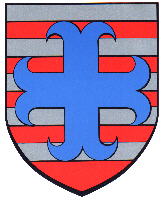Useldange: Difference between revisions
Knorrepoes (talk | contribs) m (Text replace - "'''Origin/meaning :'''<br/>" to "====Origin/meaning====") |
Knorrepoes (talk | contribs) m (Text replace - "[[Literature" to "{{media}} [[Literature") |
||
| Line 17: | Line 17: | ||
There were no historical arms for the last village, Everlange. | There were no historical arms for the last village, Everlange. | ||
{{media}} | |||
[[Literature]] : Loutsch, J-C. et al.; Armorial communal du Grand-Duché de Luxembourg, Fisch, Luxembourg, 1989, 331 p. | [[Literature]] : Loutsch, J-C. et al.; Armorial communal du Grand-Duché de Luxembourg, Fisch, Luxembourg, 1989, 331 p. | ||
Revision as of 07:35, 9 July 2014
| Heraldry of the World Civic heraldry of Luxembourg |
USELDANGE
Origin/meaning
The arms were granted on December 4, 1986.
The bars are derived from the arms of the Lords of Esch-sur-Sûre, who were also Lords of Useldange.
The cross is derived from the arms of the Lords of Septfontaines, who owned the village Rippweiler. It also symbolises the village Schandel. Schandel belonged first to the Lords of Sterpenich (in present Belgium), who also uses a similar cross in their arms. and later to the Lords of Hondelange, who used the cross with a dog's head on it.
There were no historical arms for the last village, Everlange.
Contact and Support
Partners:
Your logo here ?
Contact us
© since 1995, Heraldry of the World, Ralf Hartemink 
Index of the site
Literature : Loutsch, J-C. et al.; Armorial communal du Grand-Duché de Luxembourg, Fisch, Luxembourg, 1989, 331 p.











